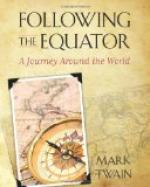“As he walks through the bush his step is light, elastic, and noiseless; every track on the earth catches his keen eye; a leaf, or fragment of a stick turned, or a blade of grass recently bent by the tread of one of the lower animals, instantly arrests his attention; in fact, nothing escapes his quick and powerful sight on the ground, in the trees, or in the distance, which may supply him with a meal or warn him of danger. A little examination of the trunk of a tree which may be nearly covered with the scratches of opossums ascending and descending is sufficient to inform him whether one went up the night before without coming down again or not.”
Fennimore Cooper lost his chance. He would have known how to value these people. He wouldn’t have traded the dullest of them for the brightest Mohawk he ever invented.
All savages draw outline pictures upon bark; but the resemblances are not close, and expression is usually lacking. But the Australian aboriginal’s pictures of animals were nicely accurate in form, attitude, carriage; and he put spirit into them, and expression. And his pictures of white people and natives were pretty nearly as good as his pictures of the other animals. He dressed his whites in the fashion of their day, both the ladies and the gentlemen. As an untaught wielder of the pencil it is not likely that he has had his equal among savage people.
His place in art—as to drawing, not color-work—is well up, all things considered. His art is not to be classified with savage art at all, but on a plane two degrees above it and one degree above the lowest plane of civilized art. To be exact, his place in art is between Botticelli and De Maurier. That is to say, he could not draw as well as De Maurier but better than Boticelli. In feeling, he resembles both; also in grouping and in his preferences in the matter of subjects. His “corrobboree” of the Australian wilds reappears in De Maurier’s Belgravian ballrooms, with clothes and the smirk of civilization added; Botticelli’s “Spring” is the “corrobboree” further idealized, but with fewer clothes and more smirk. And well enough as to intention, but—my word!
The aboriginal can make a fire by friction. I have tried that.
All savages are able to stand a good deal of physical pain. The Australian aboriginal has this quality in a well-developed degree. Do not read the following instances if horrors are not pleasant to you. They were recorded by the Rev. Henry N. Wolloston, of Melbourne, who had been a surgeon before he became a clergyman:
1. “In the summer of 1852 I started on horseback from Albany, King George’s Sound, to visit at Cape Riche, accompanied by a native on foot. We traveled about forty miles the first day, then camped by a water-hole for the night. After cooking and eating our supper, I observed the native, who had said nothing to me on the subject, collect the hot embers of




